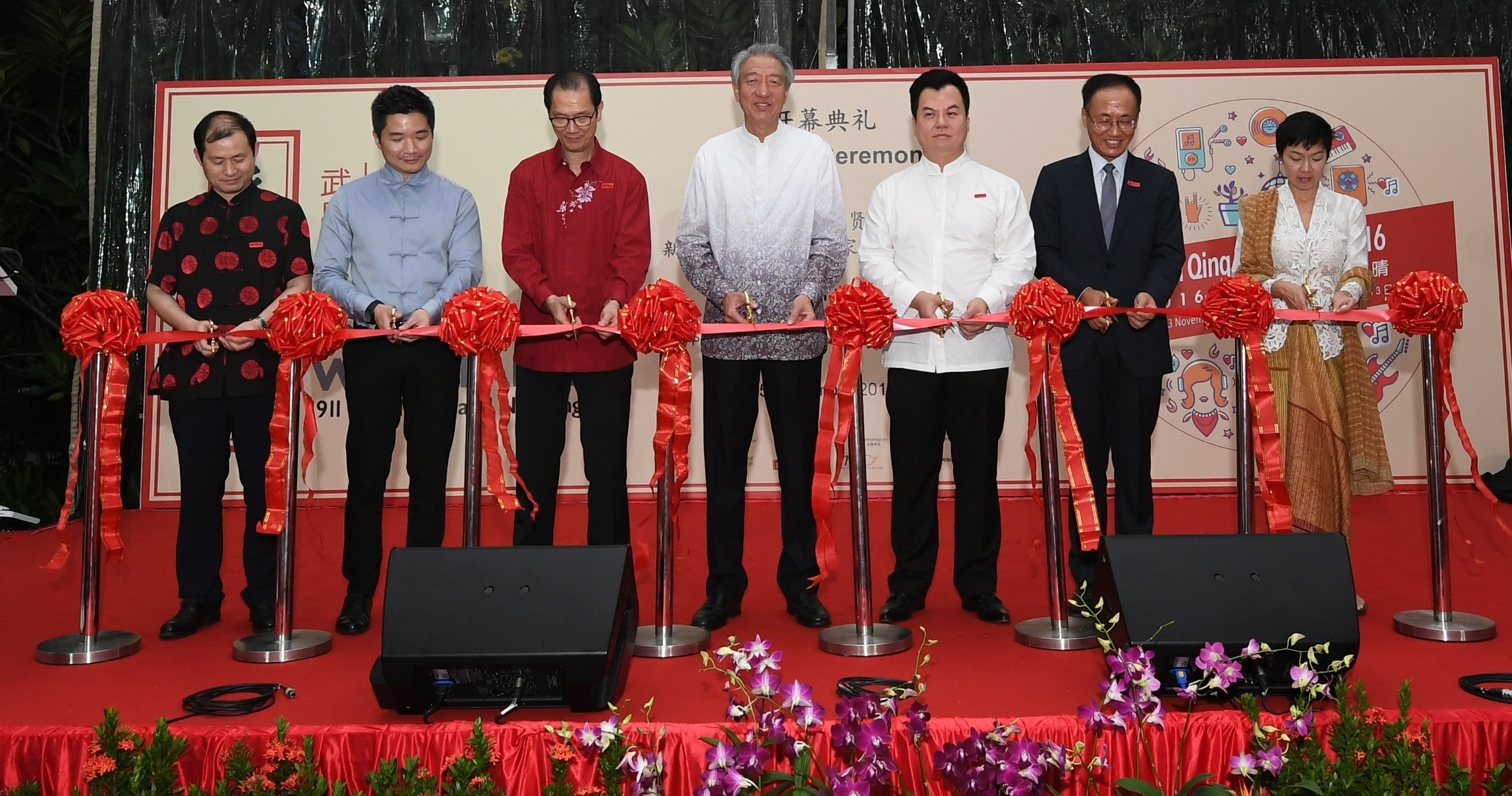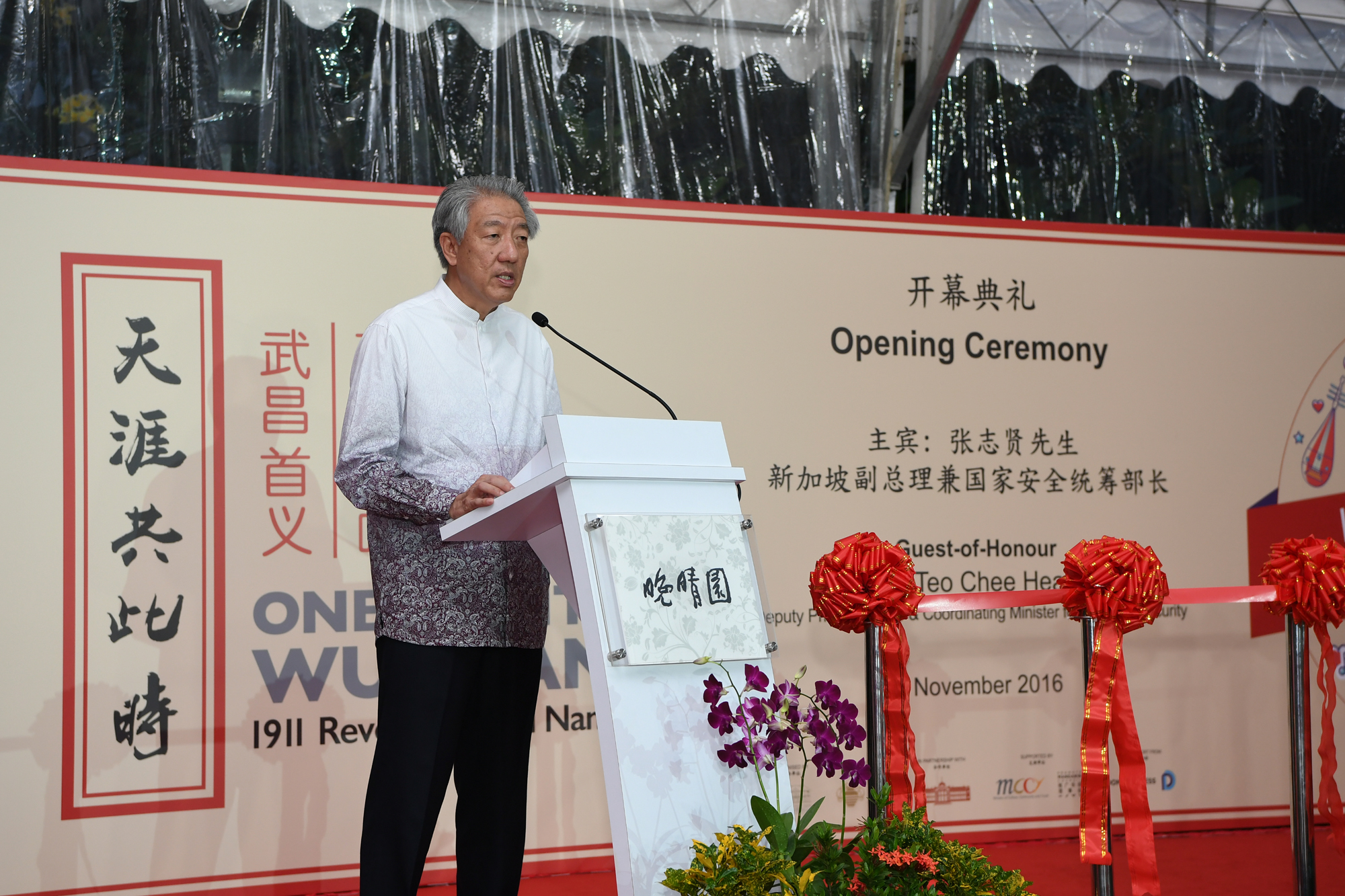Speech by DPM and Coordinating Minister for National Security, Teo Chee Hean, at the Opening of the One Night in Wuchang Exhibition on 5 November 2016.
陈晓东大使,
白南泉先生,
萧作鸣先生,
朱祥德馆长,
各位贵宾、女士们、先生们,
大家晚上好 !
我很高兴回到晚晴园,为新的特展和文化节主持开幕。
晚晴园见证了历史,也把新加坡和全球华人连接在一起。本地华社有很独特的经历:在英国殖民地时期,作为海外华侨;之后在马来西亚,作为在多元种族国家中的少数族群;到了今天,在独立自主的新加坡,作为在多元种族国家中的多数族群。这些历史,造就了今天新加坡多元种族、 多元宗教、多元文化的社会。
这些年来,政府通过各种活动推广新加坡特有的华族文化。我很高兴晚晴园和推广华语 理事会合作,在晚晴园举办文化活动,让新加坡人更了解本地华族文化、历史和贡献。同时,这也能鼓励本地社群,更支持文化活动。
华族文化 的 推广和传承, 需要大家 的 合作。让我们再接再厉,让新加坡人对本地文化遗产有更全面的认识。接下来,让我用英语发言。
“Celebrating Singaporean Chinese Culture and Heritage”
Ambassador Chen Xiaodong,
Mr Adrian Peh, Member of the Sun Yat Sen Nanyang Memorial Hall Board,
Mr Seow Choke Meng, Chairman of the Promote Mandarin Council,
Mr. Zhu Xiangde, Director of The Memorial of Wuchang Uprising of 1911 Revolution,
Distinguished Guests,
Ladies and gentlemen,
Good evening. I was at the re-opening of the revamped Sun Yat Sen Nanyang Memorial Hall five years ago. And I am happy to be back to launch the Wan Qing CultureFest 2016 and the “One Night in Wuchang” exhibition.
This year marks the 150th anniversary of the birth of Dr Sun Yat Sen. The Memorial Hall, known to many as Wan Qing Yuan, served as the Southeast Asia headquarters for Dr Sun’s revolutionary activities. Dr Sun reached out to others with an open heart. His ideal of “博爱” or “Universal Love” inspired many as he raised funds and sought the support of overseas Chinese in his fight to overthrow the Qing Dynasty. Dr Sun planned three such uprisings from this villa, before the successful Wuchang uprising during the 1911 Xinhai Revolution.
Evolving identities
This Memorial Hall provides a historical and cultural link between Singapore and the global Chinese population during a seminal phase of China’s modern historical development. The events here were set in a time when Singapore was a British colony. The Chinese here, mainly from the Mainland southern coastal provinces, came to a foreign land under the British to work and trade, contributing to their families in their home villages in China, and hoping to return home. Dr Sun came and sought their support for a New China. Many supported his cause and also contributed to relief funds for China during the Second World War. Some even returned to China to fight against the Japanese invaders. The Japanese certainly viewed the Chinese in Singapore no differently from those who fought them in China, and those here paid a hefty price during the Sook Ching operation in the early 1940s.
Wan Qing Yuan stood here watching the march of history, when after the Second World War, independence movements swept across South East Asia. Singaporeans became citizens in the newly independent Malaysia, with the Chinese community a minority in a multi-racial country. This is indeed the situation of many ethnic Chinese living overseas today – a minority within the countries where they are citizens. China began to recognise that while these overseas Chinese had cultural ties with China, they should be loyal to the countries where they have taken up citizenship. China also started to distinguish between “海外华侨” or “Overseas Chinese nationals” and “华人” or “ethnic Chinese” who took up the host country’s citizenship.
In 1965, Singapore became an independent sovereign country, with a Chinese majority in our multi-racial country. We are the only country outside of China which has an ethnic Chinese majority.
The local Chinese community in Singapore thus has gone through a unique set of experiences – as Chinese in a foreign land during the British colonial times here; as citizens in the minority in a multi-racial country Malaysia; and today as citizens in the majority in a multi-racial independent and sovereign Singapore.
These historical experiences that all our communities in Singapore have lived through together, have shaped the social compact between our communities, and the way that we relate to one another as we build a multi-racial, multi-religious, and multi-cultural society based on equality and meritocracy. Every Singaporean has a stake in the country. We share common spaces and experiences, regardless of race or religion, while each community maintains links to its language, culture and roots. When we have festivals and celebrations, or mark historical events, these are good opportunities for all races to learn about one another’s history, culture and heritage.
The Wan Qing CultureFest is one such opportunity to deepen our understanding of local Chinese culture and heritage in Singapore. I am glad that in similar ways, our Malay, Indian and Eurasian communities celebrate their culture and heritage. These activities help to enhance and deepen our understanding of all the various communities in Singapore, not just for the individual communities themselves, but for Singaporeans of all races, and as part of a larger Singaporean identity.
For our Chinese community in Singapore, we can enhance our understanding of Chinese culture and heritage and share this with other communities in Singapore, by facilitating cultural exchanges with China, by enhancing the role of heritage institutions such as Wan Qing Yuan, and by encouraging our local community to support cultural activities.
Facilitating Cultural Exchanges between Singapore and China
First, we can facilitate more cultural exchanges, collaboration and partnerships with China. To mark 25 years of diplomatic ties between Singapore and China last year, President Xi Jinping and ESM Goh Chok Tong opened the China Cultural Centre during President Xi’s State Visit to Singapore last November. This is one of 20 China Cultural Centres outside of China, and will develop more cultural collaborations between our two countries.
Then-Minister for Culture, Community and Youth, Mr Lawrence Wong and China’s Minister of Culture Mr Luo Shugang also agreed on the 7th Singapore-China Executive Programme last year. Under this programme, Singapore and China will enhance cultural exchanges in heritage, museology, performing arts, visual arts and the literary arts. These exchanges will provide opportunities for our artists and youths to showcase the best of our Singaporean Chinese culture and collaborate with their Chinese counterparts. Singaporeans can also get to enjoy more cultural offerings from China.
Enhancing the role of Heritage Institutions to support cultural appreciation
Second, heritage institutions such as the Sun Yat Sen Nanyang Memorial Hall have contributed to an increased understanding and appreciation of our local Chinese history and culture, both in Singapore and abroad. The Memorial Hall has worked closely with the Singapore Chinese Chamber of Commerce and Industry to highlight the contributions of our Chinese pioneers to Singapore. Leaders such as Mr Tan Chor Lam, Mr Lim Nee Soon and Mr Lee Kong Chian, have all played a part in Singapore’s development and the Memorial Hall’s long history.
The Memorial Hall has built strong ties with similar Chinese cultural institutions around the world. Since 2011, it has raised its profile among Sun Yat Sen institutions around the world by contributing to global understanding of the 1911 Xinhai Revolution. It demonstrates a unique link between Singapore and those all around the world who share a connection to Dr Sun. It was invited to showcase its unique Nanyang content around China, including the Museum of Dr. Sun Yat-Sen in Dr Sun’s hometown in Cuiheng Village. Last year, the Memorial Hall was invited to showcase the exhibition, A Moment in History: Singapore and the 1911 Revolution, in San Francisco, its first in the United States.
Besides this exhibition, the Memorial Hall also seeks to introduce Singaporeans to Chinese culture in fun and engaging ways. I am glad that this year’s Wan Qing CultureFest is organised in collaboration with the Speak Mandarin Campaign for the first time. This provides a good opportunity to use Mandarin and allow Singaporeans to better appreciate our local Chinese culture.
Encouraging Contributions by our local Community for Cultural Activities
Third, we can encourage our local community to support cultural activities. I am heartened that our local community has been actively involved in sharing Singapore’s arts and culture. We have seen more Singaporeans, in particular the young, take initiative to learn about Chinese culture. Several River Valley High School students for instance, have signed up as student guides for Wan Qing Yuan. We will hear stories of Nanyang retold from their perspectives later.
To encourage ground-up involvement in cultural and heritage activities, the National Heritage Board has supported over 200 such projects since 2013. These individuals and groups help to promote the appreciation of Chinese language, culture and traditions. The Singapore Federation of Chinese Clan Associations and our clan associations have also contributed to annual events such as the River Hongbao during the Lunar New Year. The Federation is also leading community efforts for the new $110 million Singapore Chinese Cultural Centre (SCCC). When the SCCC is ready next year, this will help more Singaporeans and visitors experience our unique “Nanyang-style” Chinese culture and heritage.
Conclusion
Let us work with other communities in Singapore to strengthen our collective identity.
I look forward to viewing the exhibition and watching the performances later. I wish everyone an enjoyable evening. Thank you.
Explore recent content
Explore related topics


